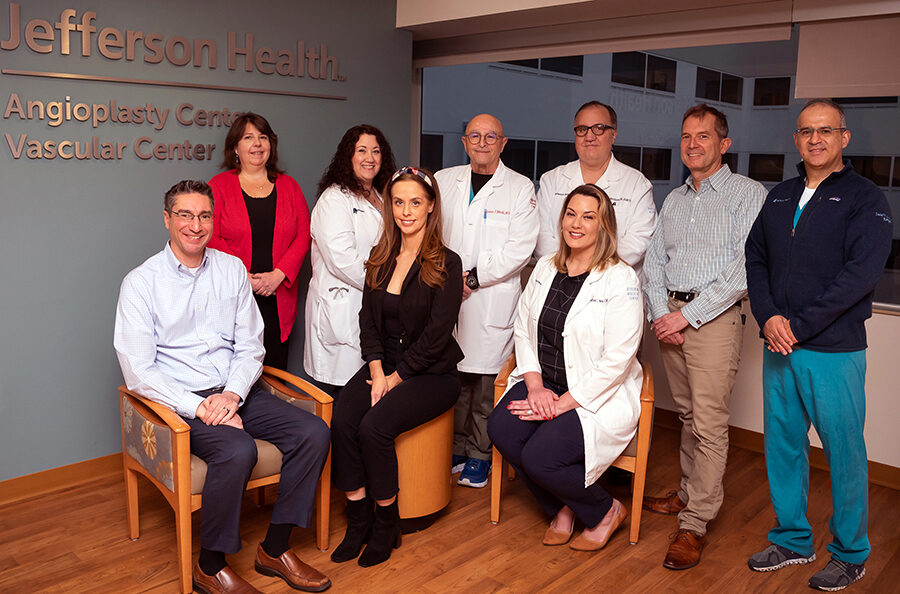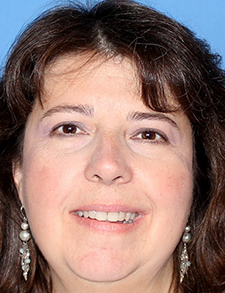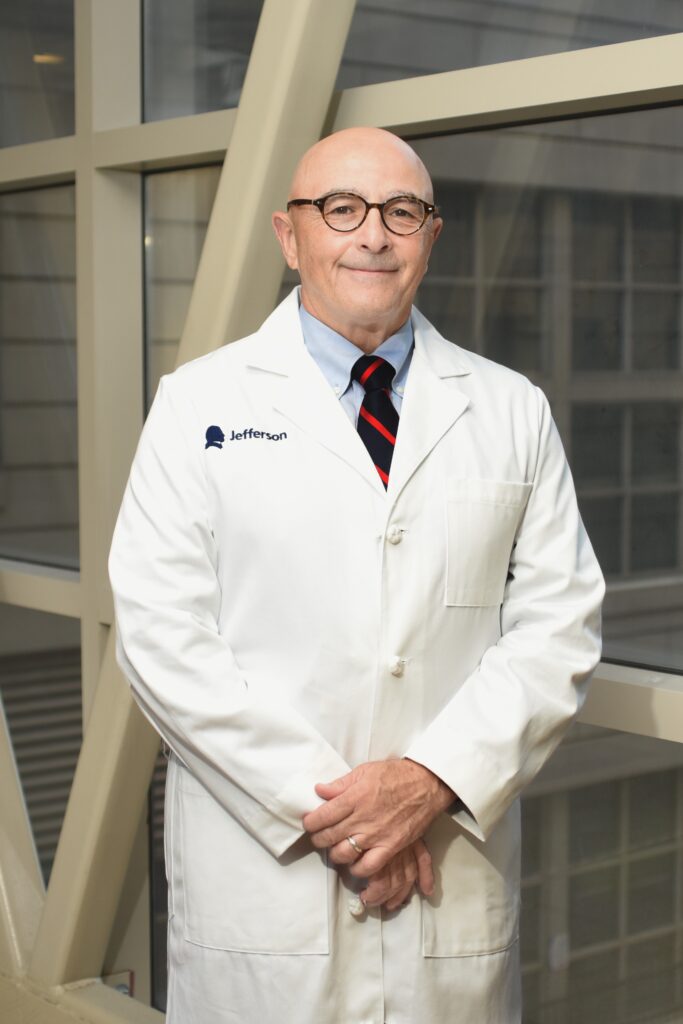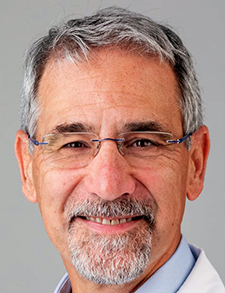
Jefferson Antithrombotic Therapy Team. Front row L to R: Photi Galanis, MD, Julia Westfield, Heather Yenser, CRNP. Back row L to R: Lynda Thomson, PharmD, Dina Orapallo, CRNP, Geno Merli, MD, Tony Macchiavelli, MD, Walter Kraft, MD, Luis Eraso, MD
Hospital clinicians know well that managing anticoagulation therapy for their patients with venous thromboembolism (VTE) and other thrombotic conditions can be a balancing act between preventing further life-threatening blood clots and avoiding dangerous bleeds—both high-risk adverse events leading to diminished quality of life and worse, for patients.
These challenges are intensified at the time of hospital discharge when poorly executed handoffs and transitions can lead to a variety of negative outcomes.1 Meanwhile, the disruptions and additional clotting concerns imposed by the COVID-19 pandemic have further complicated this tightrope walk.
But hospitalists can now turn to the lessons from SHM’s Facilitation of Anticoagulation for Safer Transitions (FAST) quality-improvement program, which ran for 20 months from 2019 to 2021. Seven hospitals of diverse sizes and settings were enrolled in FAST’s Mentored Implementation program, receiving guidance from clinician experts in VTE and anticoagulation. The bundle of interventions implemented by the hospitals to improve transitions of care for VTE patients is summarized in the implementation guide and other SHM FAST resources on SHM’s website.

Dr. Thomson
The statistics for acute VTE management are mindboggling, said Lynda Thomson, PharmD, an advanced practice clinical pharmacist at Philadelphia’s Thomas Jefferson University Hospital (TJUH) and part of SHM’s FAST faculty at TJUH. A million Americans each year experience VTEs and a half-million are hospitalized for them, while acute VTE causes 100,000 deaths annually, most often due to pulmonary embolisms.2
“Anticoagulants are regularly listed in the top 10 drugs associated with medical errors. The DOACs [direct oral anticoagulants] were supposed to simplify that, with no intravenous administration or blood monitoring required,” Dr. Thomson said. But they aren’t simple, given the confusing variety of dosing schedules, durations, and other considerations, especially when not chosen wisely or administered correctly.
“Overall, DOACs have actually worsened rates of adverse events such as medication errors,” she said. “So, you have this combination of a common disease state and a dangerous drug. When you add transitions of care, which are a high-risk time for patients, it’s like a triple whammy.”
Unsurprisingly, regulatory bodies are also paying attention, such as the Joint Commission’s 2016 quality measure, Anti-Coagulation Therapy Prescribed at Discharge.3 The Centers for Medicare and Medicaid Services are said to be considering an anticoagulation stewardship program for providers, making this a good time for hospitalists to start practicing more systematic approaches to safe management of anticoagulants, she said.
Anticoagulation for the hospitalist
In 2013 a clinical team at TJUH started a program called Jefferson Facilitating Anticoagulation for Safer Transitions (Jeff FAST),4 aimed at preventing adverse events and hospital readmissions for the large numbers of acute VTE patients seen in the emergency department (ED) and then discharged back to the community. Jeff FAST employed evidence-based guidelines to determine which patients could be safely discharged, rather than admitted to the hospital, with comprehensive patient education about the condition.5
Based on its positive outcomes, such as 100% of enrolled patients getting follow-up visits scheduled with their outpatient doctors and none reporting significant bleeds, the team was approached by SHM’s Center for Quality Improvement to adapt its ED-based FAST intervention to hospital medicine and the needs of hospitalists. Pfizer, Inc., provided financial support for SHM FAST but did not have editorial control over the development of implementation resources.
The project used SHM’s Mentored Implementation approach for helping hospitalists improve the quality of hospital care.6 Prior Mentored Implementation programs have focused on transitions of care, glycemic control for inpatients, medication reconciliation, handoffs of care, and opioid safety.
Key components of the Mentored Implementation model for improving hospital quality and safety include training physician expert mentors and pairing them with interdisciplinary hospital-based teams, often led by hospitalists. The mentor and team typically meet monthly via Zoom to review implementation strategies, impediments to improvement, and process and outcome data. The role of the four SHM FAST mentors, Drs. Anthony Macchiavelli, Andrew Miller, Catriona Harrop, and Chris Whinney, was cited as a mechanism for fostering accountability and keeping the teams on track.
SHM FAST approaches
“With the anticoagulants, you will still have bleeding events and clotting events, but you can limit those with appropriate follow-up,” Dr. Thomson said. “Part of the challenge with care transitions is that important details often aren’t communicated, patient education is not effective, patients don’t understand or follow up on their discharge instructions, or they take their medications incorrectly,” she said. That’s why it’s important to try to ensure that VTE patients get the right treatment from the outset and feel empowered to participate in their own care.
The SHM FAST core teams at participating sites typically included a lead hospitalist, a pharmacist, a nurse, an outpatient clinician, and an information technology specialist. The program followed a comprehensive, stepwise, quality-improvement approach to transitions of care for patients newly diagnosed with primary acute VTE, using evidence-based transitions incorporated into one of two bundles—either the standard SHM FAST bundle or a more comprehensive bundle with additional interventions for coordinating transitions. A standardized order set was entered into the electronic medical record (EMR) to cue clinicians for the recommended course of action.
Other priorities for improvement included appropriate patient selection and enrollment, verification of the drug’s availability and affordability, list of medications to avoid, assessment of the patient’s readiness for discharge, identification of the outpatient provider who will see the patient next, and confirmation of the patient’s comprehension of the education—using teach-back techniques for patients to demonstrate that they comprehend what they’ve been taught.
One of the important components of SHM FAST is to place a follow-up telephone call, guided by a written script, to the patient within two days of discharge from the hospital to reinforce the education received in the hospital. Another is to make sure a follow-up appointment with an outpatient provider is scheduled within a week. “All of that closes the loop in their transition of care and gets them safely plugged in to what they need from the next provider,” Dr. Thomson said.
Making sure that the medication gets into patients’ hands before they go home was found to be so important that many of the sites opted to fill the prescription and deliver it by hand to the patient in the hospital prior to discharge.
Outcomes from SHM FAST
Of a total of 1,995 referred VTE patients at the SHM FAST sites during the course of the project, 1,322 were identified as meeting the criteria for admission and enrolled. Although this was not a randomized controlled trial but rather a multi-center, non-randomized, descriptive study, it generated important data on outcomes. The project evaluated both rates of 30-day hospital readmissions for thrombotic events or major bleeds following discharge, and the utilization of EDs for VTE emergency care.
The readmission rate was only 3.8%, despite the fact that patients admitted to the hospital for VTE are by definition high-risk. A slightly higher proportion, 4.8%, visited ED for recurrent VTE or bleeds.
Three main SHM FAST process measures were rates of medication reconciliation, documented provision of patient education, and completion of follow-up phone calls within 48 hours of discharge. Medication reconciliation was successfully completed most often, at 89% for all of the sites, while 77% provided patient/family education, and 61% completed the post-discharge follow-up call within 48 hours.
The follow-up phone call from the SHM FAST team was described by some participants as tedious and difficult to complete, often because of the inability to reach the discharged patient by phone. Sufficient staffing for making these calls in the midst of the pandemic was also cited as a barrier, although the calls could be performed by a variety of staff including medical students or non-professional staff.
Some programs found that patients couldn’t be reached because they lived in shelters or group homes or just didn’t pick up their phones. But the data showed that failure to complete these calls was associated with higher rates of bleeds and ED visits.
Standardized process

Dr. Merli
For Geno Merli, MD, division director of vascular medicine and associate chief medical officer at TJUH, the SHM FAST Mentored Implementation process helped standardize anticoagulation treatment. “I listened in on most of the meetings with the mentors, who also reported back to the SHM FAST project leadership team.” He added that the commitment of participating hospitals’ senior leadership was essential to the implementation of the SHM FAST program at each site. “The C-Suite has to be part of the team and to look at what resources need to be applied, despite resource limitations from other competing demands,” Dr. Merli said.
“All our sites have continued to implement the SHM FAST bundle during the pandemic, despite surges, and after the Mentored Implementation ended,” said Jenna Goldstein, SHM’s chief of staff and director of its Center for Quality Improvement. “Through the implementation of new interventions, they modified their practice in a sustained way. It is a solid modality for supporting implementation teams. We’re now asking the sites to do a deeper dive into the data, and in particular how COVID-19 impacted their work.”
Good but not perfect

Dr. Dreicer
One of the participating sites, the University of Virginia (UVA) Charlottesville, found that its involvement in SHM FAST was strengthened by a broadly diverse interdisciplinary team of quality experts. “I was really excited by the group we were able to pull together, with participation from pharmacy, care management, nursing, patient education, and multiple medical specialties,” said SHM FAST participant Jessica Dreicer, MD, (@jessdreicer) a physician at UVA Health.
“I was also excited by how much enthusiasm there was. SHM FAST provided us with a framework, timeline, and structure to shape how we were able to make a difference with our patients, all of which was helpful.” But it allowed for flexibility of individual implementation reflecting the resources and expertise of local experts.

Dr. Morvant
“We developed a standardized workflow for making sure these patients received targeted education dedicated to their particular anticoagulant drug, using a variety of approaches,” said Angel Morvant, MD, assistant professor of medicine at UVA. Much of that education involved a dedicated pharmacist, although bedside nurses also delivered education. UVA used an existing program involving clinical and non-clinical staff to place the follow-up calls and found that the larger aims of patient safety could still be met even if the patient received the call outside of the target window, such as within 72 hours.
It was discovered that UVA Health already had a substantial library of patient education materials that many clinicians were not aware of, including for VTE. The use of an order set accessed through the EMR offered guidance on loading doses and duration and maintenance doses for the top five anticoagulants used at the institution. “With these resources, we saw our rates of providing the needed patient education increased dramatically,” Dr. Morvant said.

Dr. Hoke
Another key to success, said George Hoke, MD, a hospitalist and quality-improvement expert at UVA, was not to let the goal of perfection become the enemy of the good. “We could agree that best practice for patient education would be to have dedicated pharmacists with a sufficient amount of time to sit with the patient prior to discharge, regardless of the hour or day of the week, using a methodology to make sure the patient understood all of the components of the education.” That was not always possible to achieve during the pandemic, he said, but it doesn’t mean the program hasn’t made a big difference in quality outcomes.
“I am very happy we participated in this quality-improvement project. I think we made our care processes safer for anticoagulant treatment,” Dr. Hoke said. “We saw very low rates of readmissions. We benefitted patients, and we learned things that we can apply to other disease states.”
Larry Beresford is an Oakland, Calif.-based freelance medical journalist.
References
- Kripilani S, et al. Deficits in communication and information transfer between hospital-based and primary care physicians: implications for patient safety and continuity of care. JAMA. 2007;297(8):831-41.
- Wendelboe AM, et al. Incidence of venous thromboembolism in a racially diverse population of Oklahoma County, Oklahoma.Thromb Haemost. 2021;121(6):816-25.
- Joint Commission. Specifications Manual for Joint Commission National Quality Measures (v2016A). https://manual.jointcommission.org/releases/TJC2016A/DataElem0727.html. Published 2016. Accessed January 7, 2023.
- Think FAST: Jefferson transition-of-care program deemed safe and effective alternative to hospital stay for certain DVT patients. Cision PRWeb website. https://www.prweb.com/releases/2015/01/prweb12424026.htm. Published January 6, 2015. Accessed January 7, 2023.
- Falconieri L, et al. Facilitating anticoagulation for safer transitions: preliminary outcomes from an emergency department deep vein thrombosis discharge program. Hosp Pract. 2014;42(4):16-45.
- Maynard GA, et al. 2011 John M. Eisenberg Patient Safety and Quality Awards. Mentored implementation: building leaders and achieving results through a collaborative improvement model. Innovation in patient safety and quality at the national level. Jt Comm J Qual Patient Saf. 2012; 38(7):301-10.